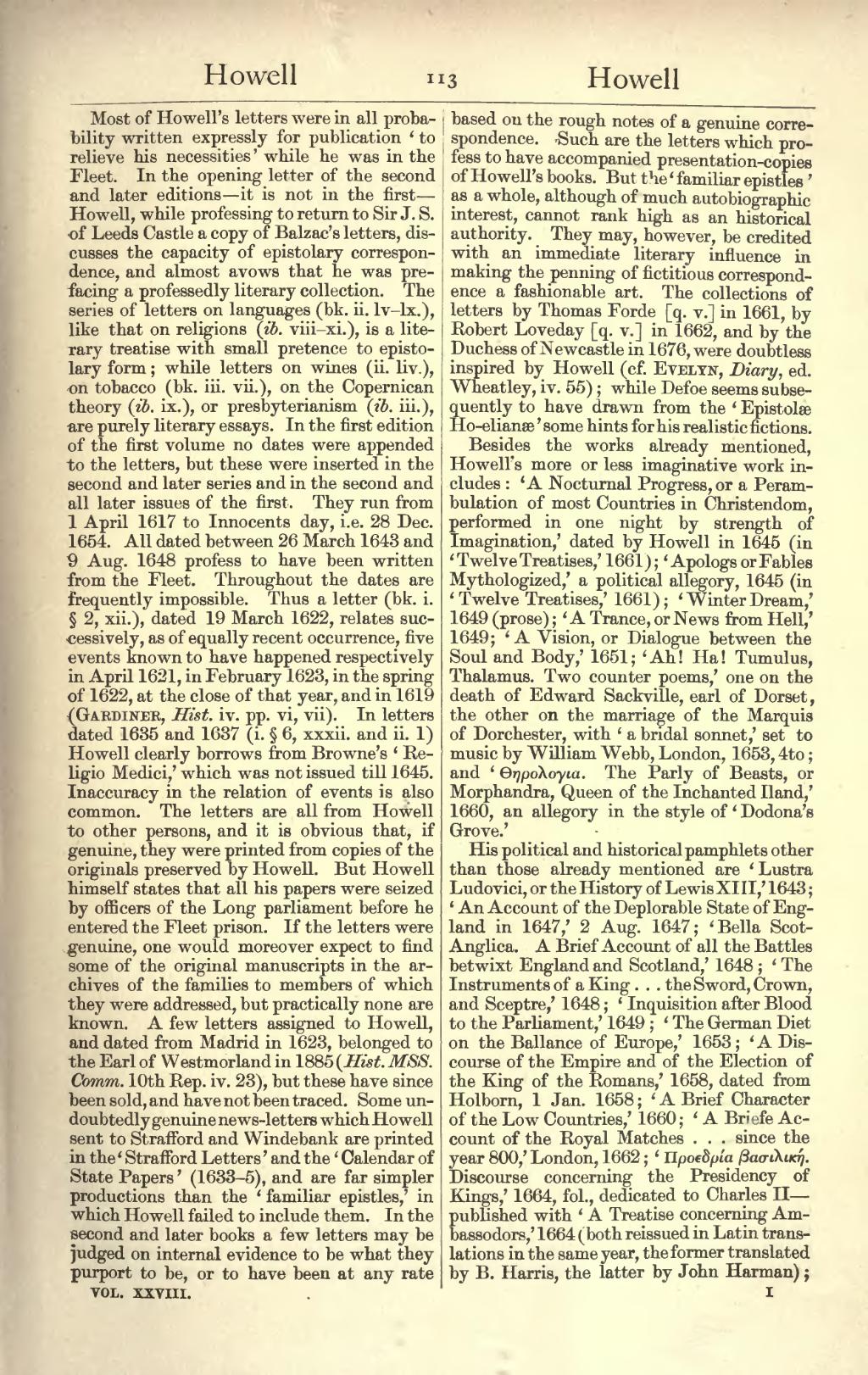Most of Howell's letters were in all probability written expressly for publication `to relieve his necessities' while he was in the Fleet. In the opening letter of the second and later editions it is not in the first Howell, while professing to return to Sir J. S. of Leeds Castle a copy of Balzac's letters, discusses the capacity of epistolary correspondence, and almost avows that he was prefacing a professedly literary collection. The series of letters on languages (bk. ii. lv-lx.), like that on religions (ib. viii-xi.), is a literary treatise with small pretence to epistolary form; while letters on wines (ii. liv.), on tobacco (bk. iii. vii.), on the Copernican theory (ib. ix.), or presbyterianism (ib. iii.), are purely literary essays. In the first edition of the first volume no dates were appended to the letters, but these were inserted in the second and later series and in the second and all later issues of the first. They run from 1 April 1617 to Innocents day, i.e. 28 Dec. 1654. All dated between 26 March 1643 and 9 Aug. 1648 profess to have been written from the Fleet. Throughout the dates are frequently impossible. Thus a letter (bk. i. § 2, xii.), dated 19 March 1622, relates successively, as of equally recent occurrence, five events known to have happened respectively in April 1621, in February 1623, in the spring of 1622, at the close of that year, and in 1619 (Gardiner, Hist. iv. pp. vi, vii). In letters dated 1635 and 1637 (i. § 6, xxxii. and ii. 1) Howell clearly borrows from Browne's 'Religio Medici,' which was not issued till 1645. Inaccuracy in the relation of events is also common. The letters are all from Howell to other persons, and it is obvious that, if genuine, they were printed from copies of the originals preserved by Howell. But Howell himself states that all his papers were seized by officers of the Long parliament before he entered the Fleet prison. If the letters were genuine, one would moreover expect to find some of the original manuscripts in the archives of the families to members of which they were addressed, but practically none are known. A few letters assigned to Howell, and dated from Madrid in 1623, belonged to the Earl of Westmorland in 1885 (Hist. MSS. Comm. 10th Rep. iv. 23), but these have since been sold, and have not been traced. Some undoubtedly genuine news-letters which Howell sent to Strafford and Windebank are printed in the 'Strafford Letters' and the 'Calendar of State Papers' (1633-5), and are far simpler productions than the 'familiar epistles,' in which Howell failed to include them. In the second and later books a few letters may be judged on internal evidence to be what they purport to be, or to have been at any rate based on the rough notes of a genuine correspondence. Such are the letters which profess to have accompanied presentation-copies of Howell's books. But the 'familiar epistles' as a whole, although of much autobiographic interest, cannot rank high as an historical authority. They may, however, be credited with an immediate literary influence in making the penning of fictitious correspondence a fashionable art. The collections of letters by Thomas Forde [q. v.] in 1661, by Robert Loveday [q. v.] in 1662, and by the Duchess of Newcastle in 1676, were doubtless inspired by Howell (cf. Evelyn, Diary, ed. Wheatley, iv. 55); while Defoe seems subsequently to have drawn from the 'Epistolæ Ho-elianæ' some hints for his realistic fictions.
Besides the works already mentioned, Howell's more or less imaginative work includes: 'A Nocturnal Progress, or a Perambulation of most Countries in Christendom, Performed in one night by strength of Imagination,' dated by Howell in 1645 (in 'Twelve Treatises,' 1661); 'Apologs or Fables Mythologized,' a political allegory, 1645 (in 'Twelve Treatises,' 1661); 'Winter Dream,' 1649 (prose); 'A Trance, or News from Hell,' 1649; 'A Vision, or Dialogue between the Soul and Body,' 1651; 'Ah! Ha! Tumulus, Thalamus. Two counter poems,' one on the death of Edward Sackville, earl of Dorset, the other on the marriage of the Marquis of Dorchester, with `a bridal sonnet,' set to music by William Webb, London, 1653, 4to; and 'Θηρολογια. The Parly of Beasts, or Morphandra, Queen of the Inchanted Iland,' 1660, an allegory in the style of 'Dodona's Grove.'
His political and historical pamphlets other than those already mentioned are 'Lustra Ludovici, or the History of Lewis XIII,' 1643; 'An Account of the Deplorable State of England in 1647,' 2 Aug. 1647; 'Bella Scot-Anglica. A Brief Account of all the Battles betwixt England and Scotland,' 1648; 'The Instruments of a King … the Sword, Crown, and Sceptre,' 1648; 'Inquisition after Blood to the Parliament,' 1649 ; `The German Diet on the Ballance of Europe,' 1653; 'A Discourse of the Empire and of the Election of the King of the Romans,' 1658, dated from Holborn, 1 Jan. 1658; 'A Brief Character of the Low Countries,' 1660; 'A Briefe Account of the Royal Matches … since the year 800,' London, 1662; 'Προεδρία βασιλική. Discourse concerning the Presidency of Kings,' 1664, fol., dedicated to Charles II published with 'A Treatise concerning Ambassodors,' 1664 (both reissued in Latin translations in the same year, the former translated by B. Harris, the latter by John Harman);
